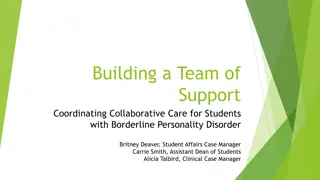Understanding Borderline Personality Disorder (BPD) and Cluster B Personality Types
Borderline Personality Disorder (BPD) is part of the Cluster B Personality Types characterized by emotional instability, impulsivity, and strained relationships. Approaches for BPD include dialectical behavior therapy (DBT) and cognitive-behavioral therapy (CBT), while interventions involve emotion regulation techniques and boundary setting. Self-care when working with BPD individuals is essential to maintain boundaries, manage stress, and seek support.
Download Presentation

Please find below an Image/Link to download the presentation.
The content on the website is provided AS IS for your information and personal use only. It may not be sold, licensed, or shared on other websites without obtaining consent from the author. Download presentation by click this link. If you encounter any issues during the download, it is possible that the publisher has removed the file from their server.
E N D
Presentation Transcript
Cluster B Personality Types, the Dramatic-Erratic Group: Overview and Focus on Borderline Personality WHAT IS BORDERLINE PERSONALITY DISORDER (BPD)? WHAT APPROACHES AND INTERVENTIONS WORK WITH BPD? SELF CARE WORKING WITH BPD.
What is Cluster B: Dramatic-erratic group? Four distinct personality types organized by descriptive similarities. These similarities separate this group from Cluster A (odd- eccentric) and Cluster C (anxious-avoidant) General requirements for all personality subtypes to meet criteria for disorder: Cultural-norm deviation (cognition, affectivity, interpersonal, impulse control) Pattern is inflexible and pervasive Clinically significant distress Stable, long duration Not accounted for by other (medical, substance, mental health)
Cluster B Antisocial Personality Disorder Histrionic Personality Disorder Narcissistic Personality Disorder Borderline Personality Disorder
Antisocial Personality General population: 3% male, 1% female Clinical population: 3% to 30% (setting dependent) Core feature: disregard for, and violation of, the rights of others At least 18 years old Evidence of Conduct Disorder onset before age 15 Does not occur exclusively during the course of schizophrenia or manic episode
Antisocial Personality, p.2 Failure to conform to social norms: law Deceitfulness Impulsivity Irritable/aggressive Reckless disregard Irresponsibility Lack of remorse: indifferent or rationalizing
Histrionic Personality General population: 2% - 3% Clinical population: 10% - 15% Core feature: pervasive and excessive emotionality and attention- seeking Uncomfortable when not the center Inappropriately seductive, provocative Rapid and shallow emotion Uses physical appearance
Histrionic Personality, p.2 Excessively impressionistic, lacking detail (shallow) Self dramatization Easily suggestible Considers relationships to be more intimate than they actually are
Narcissistic Personality General population: less than 1% Clinical population: 2% - 16% Core feature: grandiosity, need for admiration, lack of empathy Self-important Preoccupied with fantasy Believes self to be special Requires excessive admiration Entitlement
Narcissistic Personality, p.2 Interpersonally exploitive Lacks empathy Envious of others; believes others are envious of him/her Arrogant, haughty
Borderline Personality General population: 2% Clinical population: 10% - 20% Core feature: instability of relationships, self image, and emotional expressivity, marked impulsivity Frantic efforts to avoid real or imagined abandonment Intense, unstable relationships (idealization devaluation) Identity disturbance Impulsivity in 2: spending, sex, use, reckless driving, binge eating
Borderline Personality, p.2 Recurrent suicidal behaviors (acts with or without intent, threats) or self-mutilation Affective instability due to marked reactivity of mood Feelings of emptiness Inappropriate, intense anger or inability to control anger Transient stress-related paranoia or severe dissociative experiences
Getting more specific Millon, Disorders of Personality DSM-IV and Beyond BPD is one of 3 structurally defective personality types (schizotypal, paranoid) Adaptive inflexibility Self-perpetuating vicious circles Tenuous emotional balance
BPD: The Unstable Pattern Argues for the lack of utility of the term borderline as it does not describe the clinical presentation Ambivalent personality Erratic personality Impulsive personality Quixotic personality
Millons diagnostic domains Expressive behavior: spasmodic Interpersonal conduct: paradoxical Cognitive style: capricious Self-image: uncertain Object-representations: incompatible Regulatory mechanisms: regressed Morphologic organization: split Mood/temperament: labile
Millons subtypes Discouraged: sad, depressed, submissive, fear-based, insecure, helpless/hopeless alternates with brief periods of cheer, anger outbursts, resentment, fury Impulsive: capricious, superficial, seductive, evasive, worry turns to agitation, turns to gloom, hypomanic, what was once exciting is now bleak
Subtypes, p.2 Petulant: extreme unpredictability, defiant, disgruntled, discontent, sullen, pessimistic, resentful of the love they feel for others, swing from rage to pleading for forgiveness Self-destructive: perpetual vacillation, vent anger intropunitively (not externally), fear of autonomy, tries to please others (deferential, ingratiating) but do not perceive reciprocity, feel incapable, self harm and suicide
BPD: Common co-morbidities Substance use Mood disorders Eating disorders PTSD AD/HD spectrum Other PDs
Approaches to working with BPD Assess for co-morbid conditions with plan to treat Integrated care is optimal Individual, group, psychiatry, case management Assess risk and prioritize safety planning when needed Encourage family engagement DBT Manipulation? Schema Therapy
What is manipulation? Preplanned or cunning attempt to get someone to do something they ordinarily would not do, often with nefarious intent. It is a logical fallacy to assume that because you feel a certain way, the other person intended for you to feel that way.
Dialectical Behavioral Therapy Marsha Linehan Chief dialectic: validate and hold out the expectation for change Mindfulness: wise mind, emotion mind, rational mind Distress tolerance skills Interpersonal effectiveness skills Emotion regulation skills Formal, informal/modified, inpatient, outpatient
Goals Supportive, empathic stance with validation of past traumas, help the person connect present to the past when tolerable. Poor self-image aggravates the problem. Clearly establish the goal independent functioning ( responsible autonomy Linehan) at the beginning of treatment, maintain firm boundaries. Therapy starts with short term achievable goals (increase/decrease) followed by mid- to long-term process goals (family of origin, cognitive restructuring, trauma recapitulation (remembrance and mourning Herman).
Goals Help the person identify their paradoxical interpersonal conduct and how it leads to what they fear the most (eg rage at separation creates the abandonment that they are trying to avoid) which is driven by splitting with a nonintegrated emotional functioning & black-white cognitive style. Group is an excellent opportunity to offer rich interpersonal learning to try new skills, observe others, and not over-focus on a primary therapist as in the typical individual therapy session.
Self Care Caseload management Risk assessment and management Stay out of the drama (G. Lester) Rescuer Victim Persecutor Be the Scientific Observer: observe, describe, observe, describe, do not become part of the experiment you are watching. Have a hypothesis and plan to be wrong and figure out how to use the new information
Self care Use supervision Learn more about BPD and about flyfishing Do not personalize: stay cognitively loose, flexible, resist like/dislike Your feelings are natural, normal, and a tool for you, learn how to use them Be prepared for requests for self disclosure Be consistent Be a role model Find the funny























